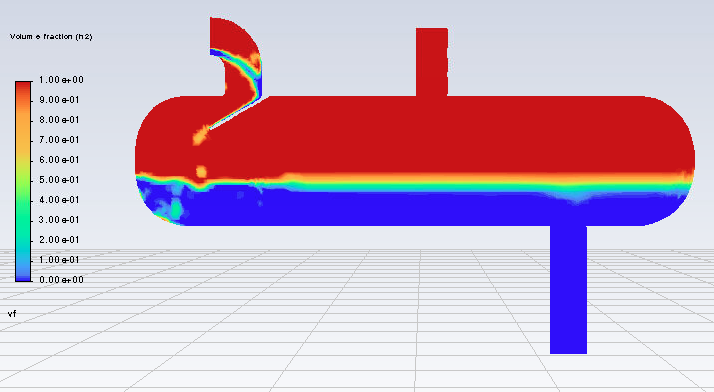-
-
November 13, 2025 at 3:34 pm
j.j.a.v.zutphen
SubscriberHello,
The problem I am trying to solve is that I want to see what kind of bubbles are created in a gas-liquid separator and how they distribute along the separator.
An image of the geometry is: A stratisfied inflow of hydrogen (red) and water (blue).
A stratisfied inflow of hydrogen (red) and water (blue).
I have also tried eulerian models, the main problem is that I have to specify the bubble diameter, which I dont know.
I think the population balance method, and perhaps combined with "Gentop" is a solution for me.
But I am having problems setting this up, right now I have 2 phases (hydrogen&water), for the pbm I need an additional third disperse hydrogen phase (I think).
When adding this phase, the vf values remain 0 for this phase since there is no creation of this phase specified.
There are options to specify a generation rate of this phase, but that defeats the whole purpose of the model estimating the bubbles generated.
Perhaps the GENTOP can solve this, however I did not find clear instructions on how to implement this.
Does anyone have a suggestion for me?
And if you think the pbm&gentop approach is reasonable could you help me with the steps in implementing.
Kind regards,
Jasper
p.s.
The domain is about 1Liter the flowvelocities 1-2m/s.
I have also looked into the Eulerian "Multifluid VOF Model" but for this the problem for the disperse diameter remains. -
November 13, 2025 at 3:51 pm
Rob
Forum ModeratorIf you have all of the kernal data then PBM and Gentop may be suitable but as you've found it's not well documented. I'm also limited to public domain material, so there's not much I can add.
However, as the PBM and Gentop models also require date and some assumptions, and you want bubble sizes because of falling film then you may need to fully resolve the bubbles using VOF. I'm fairly sure this topic's been discussed fairly recently, so you may want to review any notes in those threads.
-
November 13, 2025 at 4:54 pm
j.j.a.v.zutphen
SubscriberI have tried fully resolving VOF, even with adaptive mesh but it is computationally not feasable for me.
So for my understanding, without a fully resolved VOF, determining bubble size is not possible for now?
Would a reasonable approximation be using the eulerian with "Multifluid VOF hybrid model"?
In which case I am not interested in exactly what diameter bubbles are created but the more general flow to see the volume fraction distribution over the domain.
In case of Multifluid VOF model, the standard value for particle diameter is 1micron, determining this diameter is not trivial, but 1micron seems awfully small.
I have also noticed by trial and error that when this diameter approaches the cell size the simulation becomes unstable, so to have a fine mesh (1mm) and have a bubble size around 0.5mm is unstable.
Do you have a suggestion on the choice of dp?
Kind Regards.
-
-
November 13, 2025 at 5:21 pm
Rob
Forum ModeratorNo, the DEFAULT size in most of the Eulerian models is 10 microns, and it's usually then changed to reflect the application.
If you want to see a more general flow, at a sensible to see what's going to get carried over I'd use DPM and see what goes where. If you need the exact bubble size it's VOF. CFD isn't a magic solution to everything, it's a tool to learn more about a problem.
-
- You must be logged in to reply to this topic.


- air flow in and out of computer case
- Varying Bond model parameters to mimic soil particle cohesion/stiction
- Eroded Mass due to Erosion of Soil Particles by Fluids
- I am doing a corona simulation. But particles are not spreading.
- Centrifugal Fan Analysis for Determination of Characteristic Curve
- Issue to compile a UDF in ANSYS Fluent
- Guidance needed for Conjugate Heat Transfer Analysis for a 3s3p Li-ion Battery
- JACOBI Convergence Issue in ANSYS AQWA
- affinity not set
- Resuming SAG Mill Simulation with New Particle Batch in Rocky

-
4177
-
1488
-
1363
-
1195
-
1021

© 2025 Copyright ANSYS, Inc. All rights reserved.







